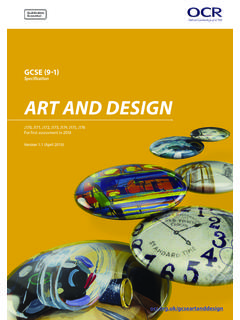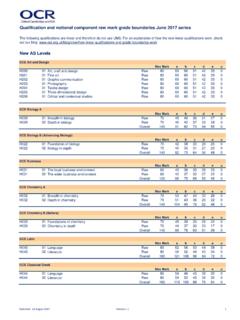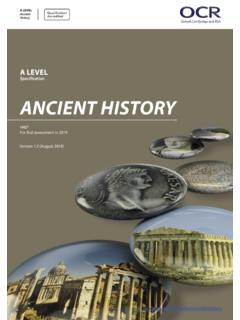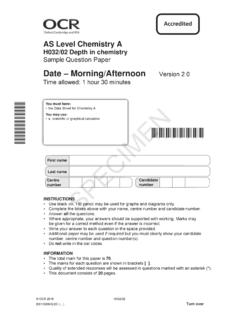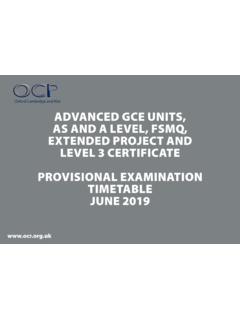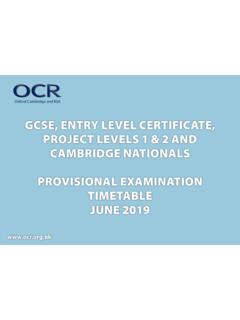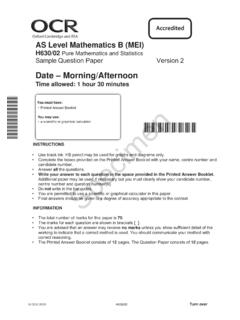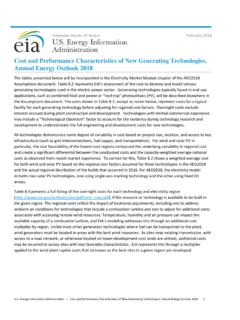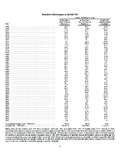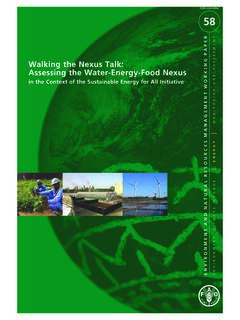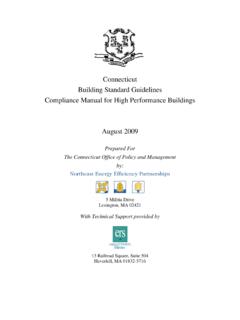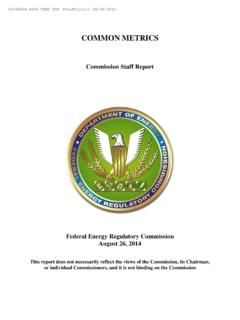Transcription of Sample Question Paper - OCR
1 OCR 2016 H555/01 Turn over QN: 601/8322/6 D10077 Oxford Cambridge and RSA A Level Physical Education H555/01 Physiological factors affecting performance Sample Question Paper Date Morning/Afternoon Time allowed: 2 hours You must have: the Question Paper You may use: a calculator * 0 0 0 0 0 0 * First name Last name Centre number Candidate number INSTRUCTIONS Write your name, centre number and candidate number in the boxes above. Please write clearly and in capital letters. Use black ink. HB pencil may be used for graphs and diagrams only. Answer all the questions.
2 Read each Question carefully. Make sure you know what you have to do before starting your answer. Write your answer to each Question in the space provided. If additional space is required, you should use the lined page(s) at the end of this booklet. The Question number(s) must be clearly shown. Do not write in the bar codes. INFORMATION The total mark for this Paper is 90. The marks for each Question are shown in brackets [ ]. Quality of extended response will be assessed in the Question marked with an asterisk (*). This document consists of 16 pages. Specimen2 OCR 2016 H555/01 Section A Answer all the questions. 1 Name one agonist and one antagonist at the ankle joint at the point of take-off during a vertical jump.
3 [2] 2 Identify the processes that occur during the fast component of excess post exercise oxygen consumption (EPOC).. [2] 3 Define linear motion and explain how linear motion is created.. [2] 4 Identify two factors that affect the horizontal distance travelled by a projectile.. [2] 5 Describe a suitable method of evaluating the aerobic capacity of an unfit, overweight 50 year old.. [2] Specimen3 OCR 2016 H555/01 Turn over Section B Answer all the questions. 6 shows a performer doing a sit up. (a) Complete the table below to show the movements that take place at the hip joint during both the upward and downward phases. Phase Agonist Movement produced Type of contraction Upward Downward [6] Specimen4 OCR 2016 H555/01 (b) shows the changes in stroke volume and heart rate from rest to maximal exercise.
4 (i) Calculate the cardiac output when the heart rate is 180bpm. Show your working.. [2] (ii) Explain the changes to stroke volume during sub maximal exercise.. [3] Rest Maximal Exercise 100 80 Stroke Volume (SV) Heart Rate (HR) 60 120 140 160 80 120 140 160 180 200 SV (ml) HR (beats/min) Specimen5 OCR 2016 H555/01 Turn over (c) Explain what is meant by the term cardiovascular drift .. [4] (d) Two netballers were arguing about the positioning of netball on the energy continuum. Discuss the suggestion from their teacher that there are many factors to consider and that they may both be correct.. [5] Specimen6 OCR 2016 H555/01 7 Table 1 shows the time in seconds that a 100m sprinter covered each 10 metre section of a race.
5 Table 1 Distance (m) Time taken (s) 0 10m 10 20m 20 30m 30 40m 40 50m 50 60m 60 70m 70 80m 80 90m 90 100m Total time seconds (a) Using the data in the table, calculate the following to two decimal places, showing your working: (i) Average velocity between 0 10m.. [2] (ii) Average acceleration between 0 10m.. [2] (iii) Average velocity during the race.. [1] Specimen7 OCR 2016 H555/01 Turn over (b) Define centre of mass . Explain how a rugby player can apply knowledge of centre of mass to increase their stability.. [4] (c) shows a gymnast performing a back somersault. Explain how angular velocity is controlled by the gymnast during take-off, flight and landing.
6 [6] Specimen8 OCR 2016 H555/01 (d) A footballer taking a free kick may apply sidespin to the ball to make it swerve. Draw and label an airflow diagram of the ball in flight. Explain how spin causes the flight path of the ball to deviate.. [5] Specimen9 OCR 2016 H555/01 Turn over 8 Table 2 shows the weekly breakdown of a hockey player s diet. Table 2 Component of diet Weekly intake Carbohydrates 50% Fats 40% Proteins 10% Vitamins and minerals Well below recommended guidelines Fruit and vegetables Below recommended guidelines (a) Evaluate the potential impact of this diet on the player s health and physical performance. Recommend changes that should be made to the intake of carbohydrates, fats and proteins.
7 [5] Specimen10 OCR 2016 H555/01 (b) Compare erythropoietin (EPO) and human growth hormone (HGH) as ergogenic aids to performance.. [5] (c) (i) Describe three physiological benefits of a warm up.. [3] (ii) Plan an effective warm up, which includes dynamic stretching, for a performer in a named activity.. [3] Specimen11 OCR 2016 H555/01 Turn over (d) Complete the table below explaining the SALTAPS assessment routine for a suspected sprain, suffered during a sporting activity. See See what happened Ask Ask what happened/where it hurts Look Look for swelling or deformity Touch Active Passive Strength [4] Specimen12 OCR 2016 H555/01 Section C 9* An elite marathon runner will have a very high aerobic capacity.
8 Explain how the aerobic system provides energy during a marathon and how cardiovascular adaptations as a result of an aerobic training programme can enhance aerobic capacity.. Specimen13 OCR 2016 H555/01 Turn over .. [20] Specimen14 OCR 2016 H555/01 Additional Answer space If you require additional space to complete an answer please use this page. The Question number(s) must be clearly shown.. Specimen15 OCR 2015 H555/01 BLANK PAGE Specimen16 OCR 2016 H555/01 Copyright Information: Section B Question 6: Dizzy. Image supplied by iStock, OCR is committed to seeking permission to reproduce all third-party content that it uses in the assessment materials.
9 OCR has attempted to identify and contact all copyright holders whose work is used in this Paper . To avoid the issue of disclosure of answer-related information to candidates, all copyright acknowledgements are reproduced in the OCR Copyright Acknowledgements booklet. This is produced for each series of examinations and is freely available to download from our public website ( ) after the live examination series. If OCR has unwittingly failed to correctly acknowledge or clear any third-party content in this assessment material, OCR will be happy to correct its mistake at the earliest possible opportunity. For queries or further information please contact the Copyright Team, First Floor, 9 Hills Road, Cambridge CB2 1GE.
10 OCR is part of the Cambridge Assessment Group; Cambridge Assessment is the brand name of University of Cambridge Local Examinations Syndicate (UCLES), which is itself a department of the University of D10077 ..day June 20XX Morning/Afternoon A Level Physical Education H555/01 Physiological factors affecting performance Sample MARK SCHEME Duration: 2 hours MAXIMUM MARK 90 This document consists of 16 pages SpecimenH555/01 Mark Scheme June 20XX 2 MARKING INSTRUCTIONS PREPARATION FOR MARKING SCORIS 1. Make sure that you have accessed and completed the relevant training packages for on-screen marking: Scoris Assessor Online Training; OCR Essential Guide to Marking.
